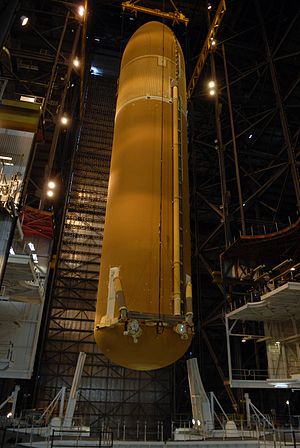
Back خزان خارجي للمكوك الفضائي Arabic Tanc extern (transbordador espacial) Catalan Space Shuttle External Tank Czech Space Shuttle External Tank German Tanque externo (transbordador espacial) Spanish Space Shuttle'i välispaak Estonian مخزن خارجی شاتل فضایی Persian Réservoir externe de la navette spatiale américaine French Tangki luar Pesawat Ulang Alik ID Serbatoio esterno dello Space Shuttle Italian
 External tank No. 124 is lowered into high bay 1 of the Vehicle Assembly Building prior to attachment of the solid rocket boosters for mission STS-117. | |
| Manufacturer | NASA Michoud Assembly Facility, contractor: Martin Marietta, later Lockheed Martin |
|---|---|
| Country of origin | United States |
| Used on | Space Shuttle |
| General characteristics | |
| Height | 46.9 m (153.8 ft) |
| Diameter | 8.4 m (27.6 ft) |
| Gross mass | 760,000 kg (1,680,000 lb) |
| Space Shuttle ET | |
| Powered by | 3 RS-25 mounted on the orbiter |
| Maximum thrust | 1,254,000 lbf (5,580 kN)[1] |
| Burn time | 510 s |
| Propellant | LH2/LOX |

The Space Shuttle external tank (ET) was the component of the Space Shuttle launch vehicle that contained the liquid hydrogen fuel and liquid oxygen oxidizer. During lift-off and ascent it supplied the fuel and oxidizer under pressure to the three RS-25 main engines in the orbiter. The ET was jettisoned just over 10 seconds after main engine cut-off (MECO) and it re-entered the Earth's atmosphere. Unlike the Solid Rocket Boosters, external tanks were not re-used. They broke up before impact in the Indian Ocean (or Pacific Ocean in the case of direct-insertion launch trajectories), away from shipping lanes and were not recovered.[2]
- ^ Aerojet Rocketdyne, RS-25 Engine (accessed July 22, 2014)
- ^ "External Tank". NSTS 1988 News Reference Manual. NASA. September 1988. Archived from the original on August 19, 2019. Retrieved January 19, 2014.